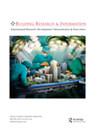Synchronization of water-energy consumption in residential and non-residential buildings during COVID-19
IF 3.7
3区 工程技术
Q1 CONSTRUCTION & BUILDING TECHNOLOGY
引用次数: 1
Abstract
ABSTRACT COVID-19 has made working from home (WFH) a widely prevalent mode of work, resulting in highly complex changes of energy and water consumption in buildings. To understand these changes, this study applies the concept of water-energy nexus (WEN) in the analysis of energy and water data in residential and non-residential buildings in Ontario, Canada, before and during the pandemic. The study found the overall energy and water consumption of buildings exhibited a decreasing trend, with the most significant change found in water consumption. Energy and water consumption increased in residential buildings but decreased in non-residential buildings; the changes in energy and water consumption were synchronized over the WFH period. This study also elucidated that changes were related to the demographic and job attributes. When dealing with the peak load of residential consumption with a high consumption benchmark, due consideration should be given to the stronger synchronization of the two types of resources to improve the resilience of residences to cope with the uncertainty of unexpected large-scale public health crisis. Applying WEN to building resource consumption during WFH for the first time, the findings shed light on the need to enhance integrated water and energy management.新冠肺炎期间住宅和非住宅建筑的水能源消耗同步
摘要新冠肺炎已使在家工作(WFH)成为一种广泛流行的工作模式,导致建筑能耗和用水量发生高度复杂的变化。为了理解这些变化,本研究将水-能源关系(WEN)的概念应用于分析加拿大安大略省疫情前和疫情期间住宅和非住宅建筑的能源和水数据。研究发现,建筑的整体能耗和用水量呈下降趋势,其中用水量变化最为显著。住宅建筑的能源和水消耗增加,但非住宅建筑的能耗和水消耗减少;能量和水消耗的变化在WFH期间是同步的。这项研究还阐明了变化与人口统计学和工作属性有关。在应对具有高消费基准的住宅消费高峰负荷时,应适当考虑两类资源的更强同步性,以提高住宅应对突发大规模公共卫生危机不确定性的韧性。首次将WEN应用于WFH期间的建筑资源消耗,研究结果揭示了加强水和能源综合管理的必要性。
本文章由计算机程序翻译,如有差异,请以英文原文为准。
求助全文
约1分钟内获得全文
求助全文
来源期刊

Building Research and Information
工程技术-结构与建筑技术
CiteScore
8.60
自引率
7.70%
发文量
43
审稿时长
>12 weeks
期刊介绍:
BUILDING RESEARCH & INFORMATION (BRI) is a leading international refereed journal focussed on buildings and their supporting systems. Unique to BRI is a focus on a holistic, transdisciplinary approach to buildings and the complexity of issues involving the built environment with other systems over the course of their life: planning, briefing, design, construction, occupation and use, property exchange and evaluation, maintenance, alteration and end of life. Published articles provide conceptual and evidence-based approaches which reflect the complexity and linkages between cultural, environmental, economic, social, organisational, quality of life, health, well-being, design and engineering of the built environment.
 求助内容:
求助内容: 应助结果提醒方式:
应助结果提醒方式:


